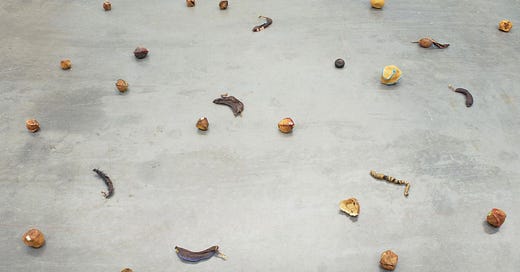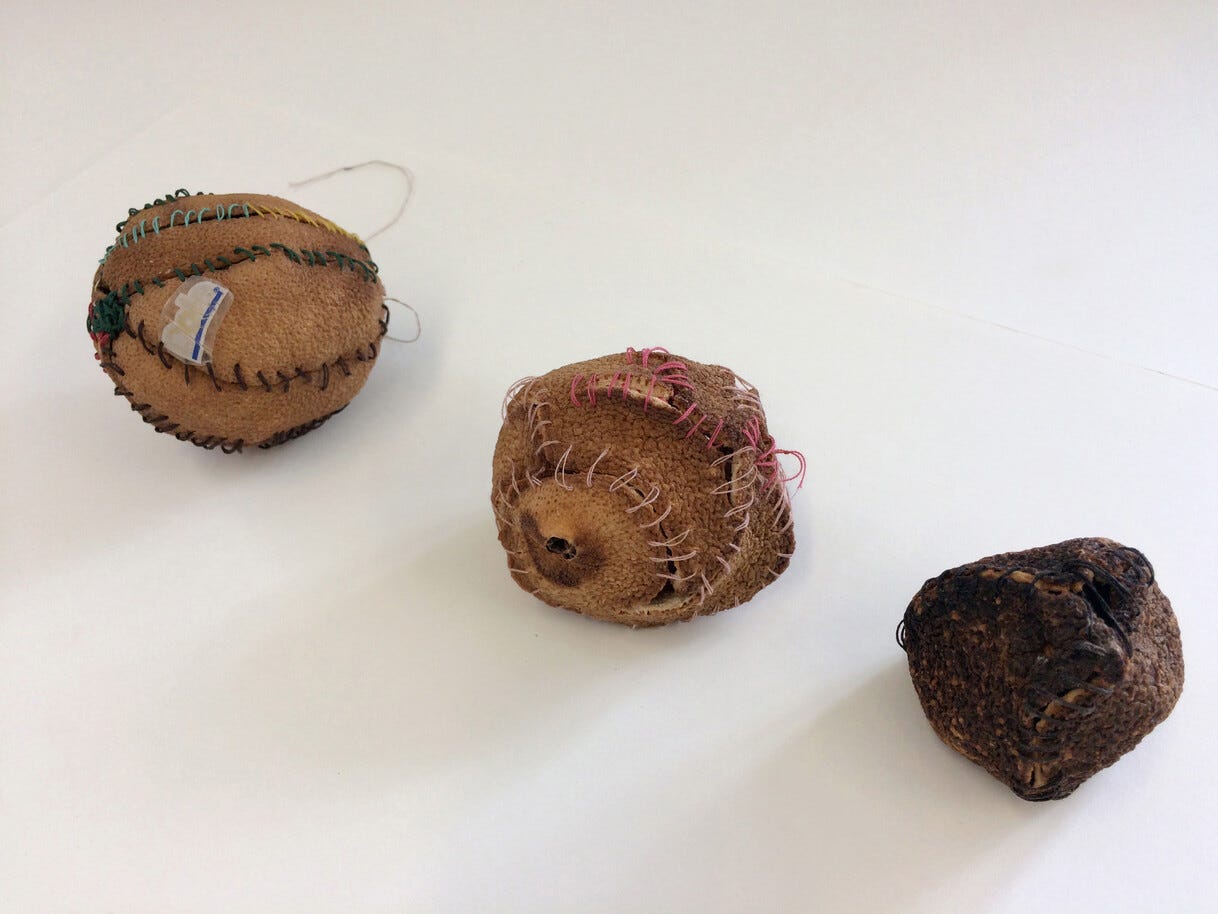I was reading The Lonely City by Olivia Laing when I came upon this piece. What baffled me at first wasn’t the piece, it was the location of said piece. The piece in question was Strange Fruit by Zoe Leonard, a permanent installment in the Philadelphia Museum of Art.
For those of you unaware, I’m from Philadelphia. I’ve been to this very museum. And I have zero memory of seeing Strange Fruit. I largely see this as a reason to go back to my beloved city and run around the museum, but that’s a discussion for another day.
Strange Fruit is at first alarming and odd. I suspect many who come upon it at first in Philadelphia would be surprised and perhaps a bit confused to come upon a room full of rotting old fruit. This alone may prompt the ire of many, with such remarks as, “Anything is art these days!” But, of course, this sentiment completely disregards the deeper meaning behind Strange Fruit.
It starts with a boy named David.
David Wojnarowicz was a young artist in the New York City scene, largely known now for his photographs of Arthur Rimbaud in New York. This was my introduction to David as well, given that I also have a deep love for the poet. Through photographs depicting one of David’s friends in a Rimbaud mask, we see Rimbaud take part in a world that no longer exists, a New York that has disappeared.
In many ways, David Wojnarowicz is similar to Robert Mapplethorpe. In fact, the two have much in common. They were both photographers, both worked primarily in New York, both came from the suburbs, both were queer, both ‘turned tricks’ for money, and both kept a sort of historical log of a hidden world looked down upon by the general public in its time. And oh right, the big one.
They both died prematurely of AIDs.
David Wojnarowicz dedicated the latter half of his life to the fight against AIDs and particularly the stigma surrounding it that led to so many deaths. He is, in fact, largely known for his work to bring awareness to AIDs, and for his death which turned into a protest. A banner was carried around the East Village stating: “DAVID WOJNAROWICZ, 1954-1992, DIED OF AIDS DUE TO GOVERNMENT NEGLECT.” Several years after his death, David Wojnarowicz’s ashes were left on the White House lawn, a reminder that though he was dead, he should never be forgotten.
I’d recommend taking the time to read up on David Wojnarowicz in detail, and yes, The Lonely City is a good start. I’m merely brushing over the big points to steer us back to Strange Fruit.
It was following the death of David that Zoe Leonard found herself lost in mourning. She was eating a fruit, peeling the skin, and discarding it around her home. Later, out of the blue, she grabbed a string and a needle and attempted to sew the fruit back together, as if to sew David together. This continued for six years, and before she knew it, Strange Fruit was born. There are around 300 fruits in total. The fruits used are bananas, oranges, grapefruits, and lemons, each stitched together in a vain attempt to revive them to what they once were.
Leonard was presented with an option to preserve the fruit, preventing its decay. While at first, this appealed to her, she realized it was not the message of the piece. Though the fruit may last up to 50 years before finally turning to dust, they are still temporal. You see, Strange Fruit is a homage to David Wojnarowicz. But also to our own heartache and the weight of grief.
A friend once told me that grief is like a balloon in a box. At first, the balloon is so big it seems to be all there is in the box, but gradually the box gets bigger. It’s not that the balloon has gotten smaller or disappeared, it’s always taking up space. It’s just that you get bigger, or I guess, stronger.
Having now lived with grief for the first time in my life, I think grief is like Strange Fruit. I think grief is a desperate attempt to keep things together, even when it's futile. Though the fruits are sewn together, they are still rotting. In time, they will be dust. We can patch them up again and again, they will still be dust.
This perspective brings me to a piece by Marina Abramovic, Balkan Baroque, that was in reaction to the Balkan War of the 90s. She swipes away at bones day after day, trying to clean them, but her attempt is futile. Worms are eating away at the bones. They will always be dirty, and they will always rot. No cleaning can change that. She goes again and again and again, but she cannot do enough.
I came upon Strange Fruit right after my grandmother died. I’ve already spoken about my desire to have memories and tangible evidence of her life, so I won’t go into that further. But I found myself ugly sobbing suddenly as I stared at images of this installation. It seemed so simple, but it hit me so deeply.
I was crying because of my grandmother. I was crying because of David Wojnarowicz. I was crying because for all that I want to give all I can so everyone has a long substantial life full of joy, I know I can’t. I cannot save the world. I cannot save the rotting fruit. I cannot save my grandmother. And I cannot save David.
I marvel that Strange Fruit has so many meanings, that I can take so much out if it. In a sense, aren’t we all broken fruit trying desperately to stitch ourselves back together? Aren’t we all wishing we could stitch each other in place? And do we have the strength and vulnerability to display these rotting parts of our souls and say, “Here I am,” to those around us?
The message is straightforward, but the depth is so insanely deep. Look at the name. You may think it’s rather to the point, but in fact, the title has more meaning than we initially realize. The title of Strange Fruit comes from a Billie Holliday song, the lyrics start with:
Southern trees bear a strange fruit,
Blood on the leaves and blood at the root,
Black bodies swinging in the South breeze,
Strange fruit hanging from the poplar trees.
Billie Holliday was singing of lynching, the hideous inheritance of our country. Naturally, this is a jazz song. Jazz is, in my opinion, the blood and sweat of the United States. It’s Ursa in Gayl Jones’ Corregidora who sings so her family history of slavery is never forgotten. Jazz is Ursa in Corregidora in that jazz is a testament, a part of history that can never escape us. Billi’e song only makes that more evident.
I don’t think it’s strange that the message of Strange Fruit extends beyond the reach of Billie Holliday’s soulful voice to the heartache brought on by the AIDs epidemic. Both are saying the same thing: What life is worth fighting for in America?
And there’s still so much more I can say of this piece. Something I find genius about Strange Fruit is the imagined stench. I haven’t seen it so I have no idea if there is a stench. Hence, imagined stench.
But then, how can it not have a stench? And how can that not give us so much more? Yes, the rotting flesh must stink. Yes, the horror of this dying fruit is grotesque. Yes, death is hideous no matter how you try to dress it up. Yes, the ugly memory of bodies tossed aside because of AIDs leaves a nasty aftertaste. And yes, our hands are stained in it. We cannot escape the rotting. It follows us everywhere.
Often I find myself thinking about Strange Fruit and looking it up to be hit in the gut. Each time, I’m thrown into a tailspin of emotion: I think of my grandmother, jazz, Billie Holliday, the blood of history, and the AIDs epidemic. I’m reminded not just of David Wojnarowicz, but of what he fought for. What we are all still fighting for, and will likely fight for again and again and again.
I suppose our history is ultimately a simple question: who deserves to have a rich, long, loving, healthy, and happy life? And I realize we have failed in our answer again and again and again.
What lives are worth saving? What lives deserve value and love and attention? Which of us are strange fruit? And what does that say about the rest of us if we are not strange fruit and we turn away from the stench of rot?
We are confronted with these questions in this piece because of how strongly it forces us to confront them. So what do you say? What do we make of this Strange Fruit?











As soon as I saw the title of this piece, I knew I wanted to sit with it for a while and give myself over to it. Because a quick glance told me right away that you intended to evoke matters of importance. I fully expected you to bring in Billie Holiday’s classic, but you touched so many other artists and issues.
I am sorry to learn of your grandmother’s transition. It’s always hard to say goodbye to those we love.
But I’m really grateful for the powerful message in this piece, and also for your social consciousness and that of the artists you’ve mentioned. Thanks for writing and sharing this.